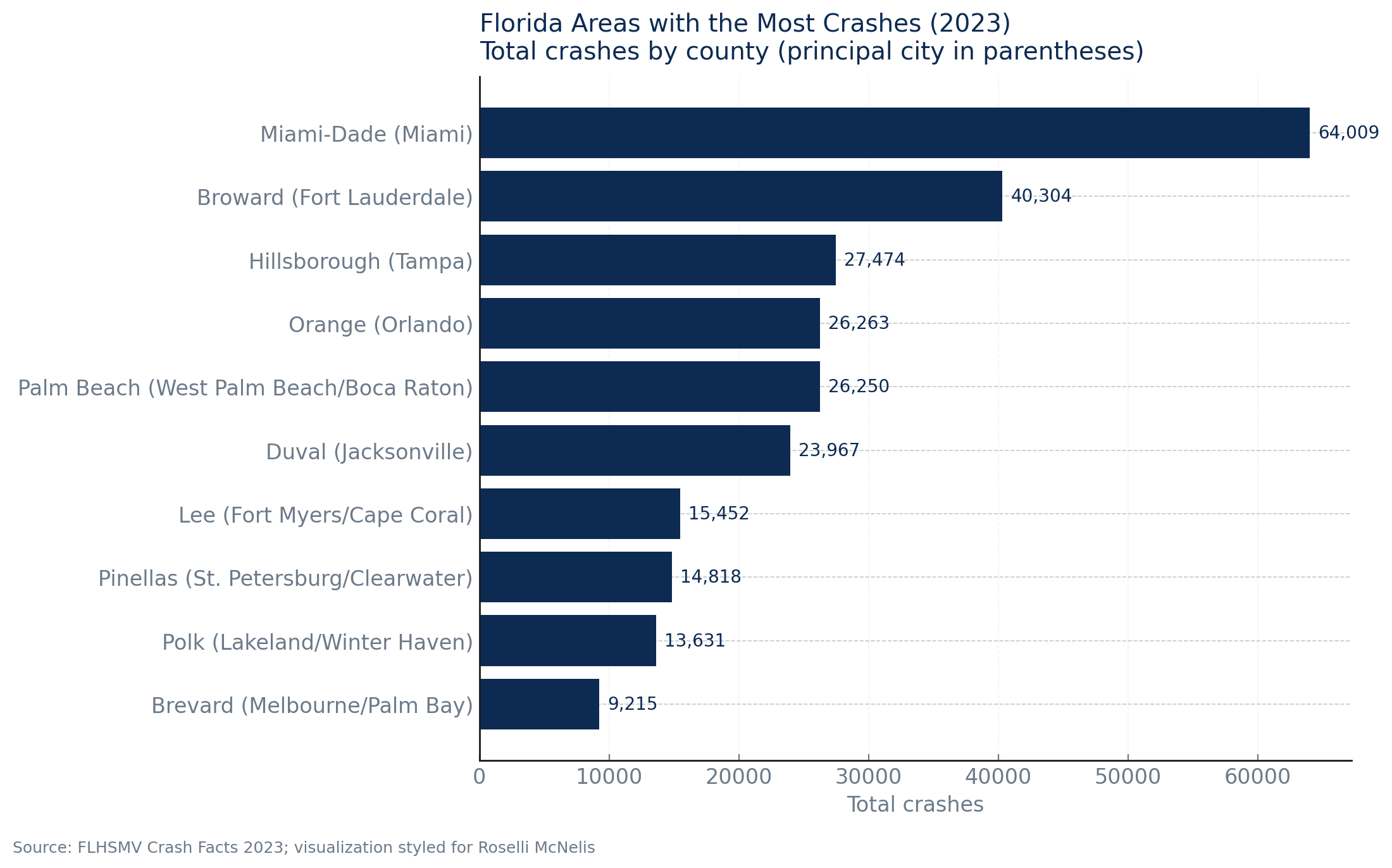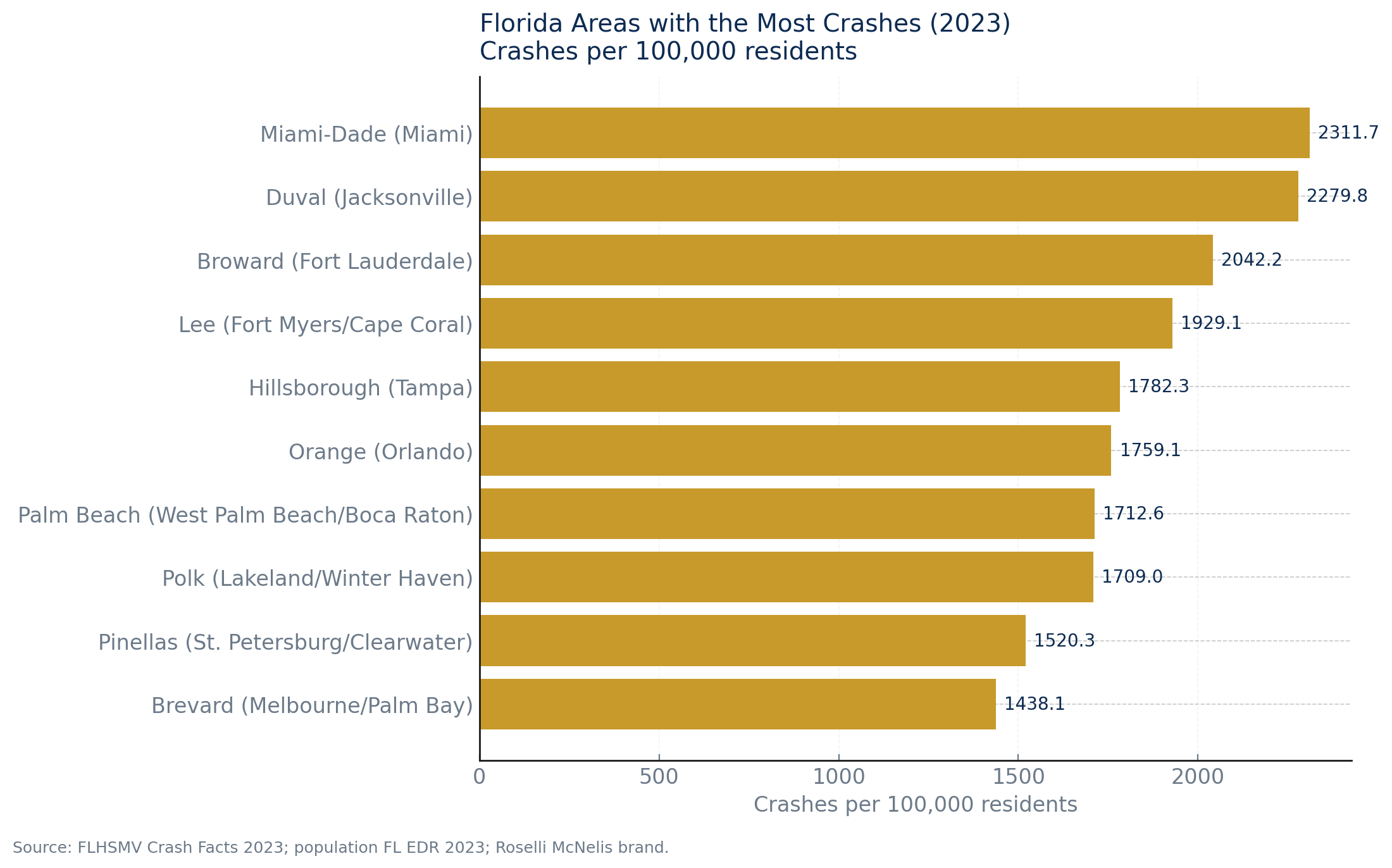Florida’s roads remain some of the busiest in the nation, with millions of residents, commuters, and tourists traveling daily. The state’s unique combination of high population density, major interstate highways, and a transient tourist population creates a volatile environment for drivers and other road users. Unfortunately, this high traffic volume also translates directly into a high number of crashes. According to the Florida Department of Highway Safety and Motor Vehicles (FLHSMV), 2024 was another challenging year on the roads, with a staggering 381,210 crashes statewide, leading to thousands of injuries and tragic fatalities. While the numbers have shown some fluctuations year over year, the core issues of roadway safety and accountability persist.
By looking at these numbers more closely, we can move beyond the general statistics to understand where Florida’s crash problem is most severe and which road users are most at risk. This data-driven analysis is crucial for both raising public awareness and for helping to hold negligent drivers accountable.
Understanding the Numbers: Florida Crash Statistics at a Glance

The raw data from the FLHSMV paints a sobering picture of the state of Florida’s roads in 2024. The total number of incidents—at 381,210—represents an immense volume of motor vehicle accidents, averaging over 1,000 crashes every single day. This figure, while immense, only tells part of the story. The true human cost is revealed in the breakdown of injuries and fatalities.
- Total Crashes and Fatalities: In 2024, Florida tragically experienced 3,184 traffic fatalities. While this figure represents a slight decrease from the previous year, it still positions Florida as one of the states with the highest number of traffic deaths nationwide. These aren’t just statistics; they are parents, children, and friends whose lives were cut short.
- Hit-and-Run Incidents: A particularly alarming trend continues to be the high rate of hit-and-run crashes. The FLHSMV reported 85,089 hit-and-run crashes, which tragically resulted in 205 deaths. This represents a severe public safety crisis, as drivers who flee the scene not only evade responsibility but often leave victims without immediate medical aid.
- Teen-Related Crashes: The risks faced by young drivers are also a significant concern, with 82,447 crashes involving teen drivers. This highlights the importance of continued driver education and the unique challenges faced by new drivers on Florida’s complex roadways.
These figures show that while overall crash numbers dipped slightly compared to 2023, the risks remain alarmingly high—especially for pedestrians, cyclists, and motorcyclists, who together account for a disproportionately high percentage of all fatalities.
The Unseen Crisis: Fatalities Among Vulnerable Road Users
While car-on-car accidents dominate the total crash numbers, the most devastating outcomes often involve what the FLHSMV classifies as “vulnerable road users.” These are individuals who are not protected by the steel frame of a vehicle and are therefore at a significantly higher risk of serious injury or death in a collision. The 2024 data makes it unequivocally clear that these groups bear the brunt of the state’s traffic dangers.
- Pedestrian Fatalities: A staggering 565 pedestrians lost their lives in Florida traffic incidents in 2024, accounting for approximately 22% of all traffic fatalities. An additional 7,204 pedestrians suffered injuries. Florida consistently ranks as one of the most dangerous states in the nation for pedestrians. This can be attributed to a combination of factors, including poorly designed intersections, distracted drivers, and a lack of adequate crosswalks and sidewalks in rapidly developing urban and suburban areas.
- Motorcyclist Fatalities: Motorcycle crashes claimed the lives of 482 individuals in 2024, representing approximately 18.5% of all crash fatalities. There were a total of 8,193 motorcycle crashes, resulting in 7,060 injuries. Motorcyclists are often at risk due to a lack of driver awareness. Many crashes are caused by drivers who fail to see a motorcycle in their lane, make an illegal turn in front of them, or fail to yield the right-of-way.
- Bicyclist Fatalities: The number of bicyclist fatalities in 2024 reached 80, which represents approximately 6.5% of total fatalities. This occurred across 6,590 crashes. The shared use of roadways by cars and bicycles, particularly in tourist and highly congested urban areas, creates a constant state of risk. The lack of protected bike lanes and the prevalence of distracted driving make cycling a high-risk activity in many parts of the state.
When combined, the numbers for these vulnerable road users—pedestrians, motorcyclists, and bicyclists—represent nearly half of all crash fatalities in Florida, despite making up a small fraction of the overall population on the roads. This fact alone underscores a critical public safety issue that demands immediate attention.
Why Florida’s Numbers Are Consistently High: An Analysis of Contributing Factors
Florida’s persistently high crash totals are not a coincidence. They are the result of a complex and interconnected set of factors that define the state’s unique geography, population, and culture.
- Population Growth and Tourism: Florida’s population continues to swell with new residents moving to the state every year. This is compounded by the fact that the state welcomes over 100 million tourists annually. This influx of both permanent and temporary residents puts an immense strain on the existing road infrastructure. Many of these drivers are unfamiliar with local roads, have different driving habits, or may be distracted by the purpose of their trip, whether it’s navigating new neighborhoods or enjoying a vacation.
- Major Interstate Highways: The state is crisscrossed by a network of high-volume, high-speed highways that funnel traffic through its major urban centers. Corridors like I-95, I-4, I-75, and the Florida Turnpike are not only major commuter routes but also serve as the primary arteries for long-distance travel. The sheer volume of traffic, combined with high speeds and a constant flow of entering and exiting vehicles, raises the risk of multi-vehicle crashes, which are often more severe.
- Urban Density and Congestion: Florida’s major metropolitan areas—including Miami, Orlando, Tampa, and Jacksonville—are densely populated and highly congested. This urban density leads to a high number of crashes at intersections, which are often complex and feature a mix of drivers, pedestrians, and cyclists. The combination of traffic bottlenecks, distracted driving, and the frustration that comes with sitting in traffic are significant contributing factors to fender-benders and more serious collisions.
- Weather and Environmental Conditions: While Florida is known for its sunny weather, it is also prone to sudden, severe thunderstorms and torrential rain. These sudden weather events can turn a dry roadway into a slick, dangerous surface in a matter of minutes. The sudden reduction in visibility and traction often leads to a spike in crashes. Tropical storms and hurricanes also play a role, as they can cause flooding, power outages, and debris on the roads that create hazardous conditions.
- Distracted and Impaired Driving: Despite ongoing public awareness campaigns, distracted driving remains a significant factor in Florida’s crash statistics. The use of cell phones for texting, navigation, or social media takes a driver’s eyes and focus off the road. Similarly, impaired driving, whether from alcohol or drugs, continues to be a tragic cause of crashes, especially on weekends and holidays.
The Most Dangerous Areas: Geographic Hotspots in 2024

While crashes happen everywhere, the FLHSMV data allows us to identify the geographic hotspots where the problem is most severe. These areas are not only the most populous but also feature a unique combination of the contributing factors mentioned above.
- Miami-Dade County: As Florida’s most populous county, Miami-Dade consistently records the highest number of crashes, injuries, and fatalities. The combination of dense urban traffic, major highways like I-95 and the Florida Turnpike, and a complex network of multi-lane streets creates a high-risk environment. The county is also known for a high number of hit-and-run incidents and a particularly alarming rate of pedestrian and bicyclist fatalities due to its walkability and high traffic volume.
- Broward County: Immediately north of Miami-Dade, Broward County also experiences a high volume of crashes, particularly on I-95, I-75, and local roads that feed into Fort Lauderdale and other densely populated areas. The sheer volume of commuter traffic and tourist vehicles makes this area a constant source of traffic incidents.
- Palm Beach County: Home to West Palm Beach, Boca Raton, and Palm Beach Gardens, this county sees a significant number of crashes, particularly on I-95 and the Florida Turnpike. The area is a hub for both permanent residents and seasonal visitors, leading to a mix of driving styles and unfamiliarity with the roads. The high number of crashes often occurs during peak snowbird season and on major holidays.
- Orange County: Centered around Orlando and its world-famous theme parks, Orange County is a crash hotspot fueled by tourism. The sheer volume of rental cars, buses, and out-of-state drivers navigating a complex network of roads and interchanges—including I-4 and the Florida Turnpike—creates a constant risk for collisions. The county also has a high number of crashes involving pedestrians and cyclists, especially around entertainment districts and tourist areas.
- Hillsborough and Pinellas Counties (Tampa Bay Area): The Tampa Bay area, with major hubs in Tampa and St. Petersburg, sees a high number of crashes due to its rapid population growth and a sprawling network of bridges, causeways, and interstates. The area’s complex road system can be confusing for drivers, and a high number of distracted driving incidents are reported.

A Call to Action for Florida Drivers
The 2024 data confirms that Florida’s roads remain dangerous, especially in its largest metropolitan areas and on its busiest highways. Vulnerable road users—pedestrians, cyclists, and motorcyclists—continue to face outsized risks. The persistence of hit-and-run crashes and the high number of teen-related incidents also highlight the need for continued public awareness and enforcement.
While the overall numbers show a slight decline, this is no reason for complacency. For residents of South Florida, including West Palm Beach, Boca Raton, and Miami, these numbers highlight the critical importance of defensive driving, remaining vigilant for other road users, and adhering to all traffic laws. It is a reminder that a single moment of inattention can lead to devastating consequences.
At Roselli McNelis, we remain committed to protecting victims of serious car crashes and ensuring that justice is served for those impacted by Florida’s dangerous roadways. When negligent or reckless driving leads to injury or fatality, holding the responsible parties accountable is the only way to seek fair compensation and to help prevent similar tragedies from happening in the future.






